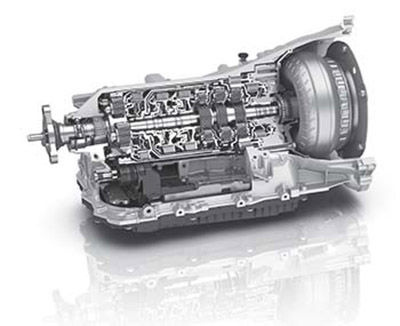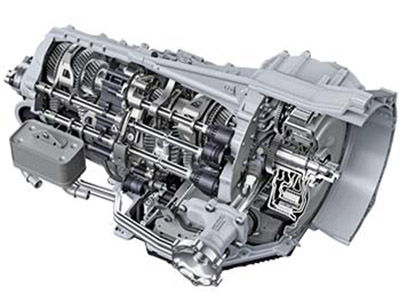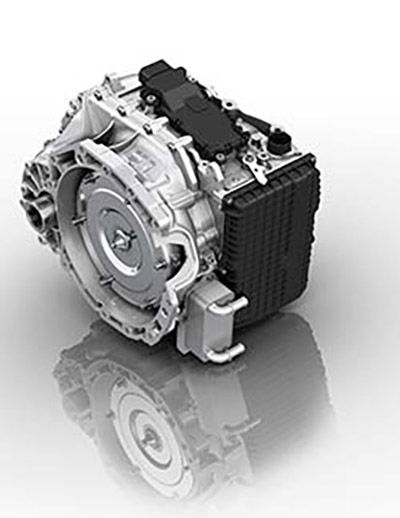Dr. Jürgen Greiner is the development
head of passenger car transmissions for
ZF. And while he agrees, “in principle,”
that “transmissions with higher transmission-
ratio spreads and more gears
with smaller gear steps… reduce fuel
consumption,” it is also his position that
, “Generally, the number of gears is not a
primary feature of a transmission for ZF.
When it comes to developing transmissions,
the relevant factor is not the number
of gears but the spread of gear ratios
and drivability that plays an important
role; the number of gears is simply the
result. Only with excellent shift quality
is a high number of gears perceived
as comfortable — with no tractive force
interruption.”
But of course the need for speed will
always exist for drivers of all stripes. As
Stadtfeld points out, “Although efficiency
is very important today, the higher
number of gears also manages an immediate
adjustment of the ratio to a point
where the engine is capable of the highest
possible power delivery in order to realize fast acceleration.”

Premiere in the BMW 5 Series: The 520d is the first
production model to come off the production line with the
new ZF 8HP transmission generation (Photo courtesy ZF).
- Click image to enlarge
By the way — just what kind of transmissions
are we (or should be) talking
about? For our general purposes,
two — 1) the best-known-in-the-U.S.
automatic transmission (AT); and 2)
the continuously variable transmission
(CVT), well known and used in Japan.
Though others exist, the talk is mainly
about ATs vs. CVTs, along with some
“hybrid-type” transmission talk as well.
ZF’s Greiner begins some transmission
anatomy for us:
“An automatic transmission (AT) comprises
several (planetary) gearsets, in different
quantities and combinations. For
example, there are four planetary gearsets
in the new ZF 9-speed automatic
transmission. The various ratios — i.e.,
gears — of the planetary gearset are generated
by fixing one gear and by connecting
and disconnecting various
shafts. This is done using so-called shift
elements (friction shift elements such
as multi-disk clutches or multi-disk
brakes), and constant-mesh elements. In
the new 9-speed automatic transmission,
there are a total of 6 shift elements, two
sets of multi-disk clutches and brakes, as
well as two dog clutches — a first in passenger
car automatic transmissions.
“Most types of transmissions are
stepped transmissions. This means they
have a specific number of gear pairs
that offer a fixed number of gear ratios,
depending on the design. The power
range of the combustion engine cannot
be fully harnessed, however, with this
limited number of transmission stages.
In contrast, a continuously variable transmission
(CVT) is, as the name suggests, a
transmission that can change seamlessly
through an infinite number of effective
gear ratios. This is particularly beneficial
for the characteristics of a combustion
engine. Along the entire engine performance
graph, operation can be adjusted
with a continuously variable transmission
ratio to achieve optimum fuel
consumption or fastest acceleration on
request.”
But, as Greiner then adds, “Unlimited
speeds, like in the case of the CVT,
reduce efficiency since you need energy
for the transmission of power. The
system-related lower efficiency; limitations
when transmitting torques; the
maximum transmission ratio range to be
achieved; and the higher weight reveal
the physical limits of (CVT) design. The
CVT is the most demanding and most
expensive (to manufacture).”
“A ‘conventional’ gear transmission is
really region-specific,” Mack points out.
“In, say, North America, it (transmission)
would be a torque converter, planetary
automatic. In many other parts of
the world (e.g., most of Europe) it would
likely be a manual transmission.
“There are also many variants of
‘hybrid transmissions’ under consideration,”
says Mack. “Most current
hybrids in passenger cars today are electric
hybrids. With many possible variants
— from an inline electric motor
on the transmission input to the wellknown
input split transmission as used
in the Ford Escape, which has two electric
motors with an internal combustion
engine, with one motor operating across a planetary gearset — creating an (IVT).”
But, “Maybe the name ‘conventional’
automatic transmission becomes outdated,”
suggests Stadtfeld. “In the U.S.,
from the 1950s until the early 2000s, these
kinds of transmissions with three and later
mainly four-speeds were most popular.
Then even more speeds were introduced
in conventional ATs. In addition, CVTs
and double-clutch transmissions (DCTs)
had been introduced. For example, the
market share of CVTs in 2014 is around
19% of all automatic transmissions
(Source: EPA Technology Trends 2014).
“The gears transmit the power via
positive-form engagement, whereas the
clutches transmit the power via friction
contact. Nevertheless, due to the intelligent
use of other positive-engagement
units like dog couplings, lamellae brakes
can be replaced, helping to reduce friction
losses. An additional standard element
to improve the efficiency is the
lock-up clutch to bypass the torque
converter in situations when it is not
required and would only lower the efficiency
due to slippage.

ZF’s enhanced second-generation, eight-speed automatic
transmission (8HP) is designed to provide effective support for
automotive manufacturers in meeting the ever-stricter legal CO2
standards — and in a cost-effective manner in combination with
conventional or hybridized drives (Photo courtesy ZF).
- Click image to enlarge
“CVTs require, next to their variable
transmission unit,
either a lamellae
clutch or a torque
converter as a startup-
element. The
power is then transmitted
to one of
the variable coneshaped
pulleys.
This pulley transmits
the power via
a metal push belt to
the other pulley that
transmits the power
to the output shaft.
The required ratio
is generated by an
adverse variation
of the two pulley
diameters. The power is transmitted via
friction contact. For this reason the pressing
forces between the pulleys and the
belt need to be high enough to avoid slippage
at the required torque. This leads in
general to a high power consumption of
the internal hydraulic system and the friction
between the belt joints, lowering the
efficiency of the system.”
Well what then of the ballyhooed (gasand-
electric-powered) hybrids?
Says Stadtfeld, “Today there is a large
diversity, with increasing numbers of
automatic transmissions based on different
concepts. The tendency is that
the market share of conventional automatic
transmissions is going to decrease
in certain segments, like medium and smaller vehicle classes, and the diversity
increases. Other forms will appear — like
DCTs, or more exotic transmissions like
IVTs — and will deliver the torque and
efficiency requirements while having
lower costs and acceptable comfort.”
Is it harder to design these new transmissions
for Cadillacs than Fiats, for
example?
As Mack explains it, “The role of the
transmission is to most effectively integrate
the requirements of the vehicle to
the characteristics of the engine. It is
really all about transferring the power
from the internal combustion engine
to the wheels. The transmission ratio
essentially defines the speed at which
the engine operates, and we need to get
the engine into its most efficient zone
of operation. If the engine torque is
reduced and the vehicle requirements
remain the same, the transmission will
need to be “longer lever” — i.e. more
ratio coverage. We also need smooth
transitions from one discrete ratio to the
next and sufficient refinement. The level
of challenge in designing for a powerfulluxury
vehicle or a smaller segment is
very much the same.”
Greiner believes that, “In principle, it
makes sense to use transmissions with
higher transmission-ratio spreads and
more gears with smaller gear steps to
reduce fuel consumption.”
But with increasing ratios come, it
would seem, greater complexity.
Greiner responds that, “If we could fit
even more gear steps in the space currently
available, it is initially technically
possible for the number of gears to reach
double-digit figures. Gradually, we are
reaching the boundaries of what is sensible.
For example, the transmission’s
spread of gear ratios is now so wide that
engines are at the limit of being drivable.
Electric motors and combustion engines
need to be combined to work together
in harmony. Integrated electronics as
well as an intelligent drive management
embedded in driver assistance functions
are necessary to achieve this.”
While it is hoped the above back-andforth
has brought some clarity to the
discussion of newest-technology, CO2-
friendly automobile transmissions, the
question arises: If there were no air pollution,
would we even be having this discussion,
or is this transmissions evolution
simply a marketplace inevitability?
What a stupid question to ask engineers.
“In our nature as humans, essentially
we always want to improve upon the
status-quo, and strive for a competitive
advantage,” says Mack. “The competitive
marketplace drives the need for more
features, more performance, driving ‘fun’
and, of course, higher value. The government
regulations are merely accelerating
the rate of development with certain criteria
in mind. The drive for lower CO2
emissions or higher MPG can also be
viewed as wasting less energy. Over the
prior century we have constantly evolved
the science of transmission engineering
with a common goal — to increase efficiency,
transfer more of the torque, and
waste less.”
“Pollution is only one aspect why we
have this transmission evolution,” says
Stadtfeld. “Besides the cost of gasoline
for the consumer, also the production of
gasoline is connected to certain environmental
implications. Vehicles with auto-matic transmissions newer than model
year (MY) 2010 already consume, on
average, the same or less amount of gasoline
than their manual counterparts,
while offering other advantages. For
example, current and future automated
driving systems would be impossible
with manual transmissions. In addition,
more gears deliver a smoother driving
experience with better capability to
use the engine’s power. But more gears
require the transmission to be automatic
because only a very few people would
accept shifting through 9 or more gears
in a car while constantly watching the
optimal shift timing to achieve smooth
and efficient driving.” Here’s one last big
question: Which of the new technologies
has the best chance of replacing “conventional”
transmissions? Is there a logical
endgame?
It depends. Good luck defining “conventional,”
for instance, when describing
transmissions.
“This is not an easy question to
answer, and I wish I had a crystal ball,”
Mack admits. “The definition of a ‘conventional
transmission’ is not standing
still, and is regionally defined. There are
two primary factors to consider. First,
from a propulsion system viewpoint, we
need to attain an optimum system efficiency,
which includes using the transmission
to “move” the operating point
of the engine into its sweet-spot; and
secondly, the transmission itself, regardless
of architecture chosen, will evolve
to constantly improve the state of art.
Gears have been and will likely remain
the most efficient method of transferring
torque. Amongst the ‘new transmissions’
we would include DCTs and
many hybrid electric variants. With
recent developments in some CVT technologies,
there may be a challenge on
the horizon. There are multiple technologies
with promise and the potential
means to effectively achieve the goals.
We continue to see an evolving mix
of technologies — with no single winner.
Consumer demand will also play a
role in the proliferation of technologies
on our roads. Pros and cons are unfortunately
not based merely on technical
merit, but also on many other market
drivers; e.g. — legislation, consumer
acceptance, cost, manufacturing investment,
etc.”
“We see new focal points” Greiner
allows — if not so much for gears — “in
the field of power electronics, the intelligent
driving strategy, the development
of ever improved electric motors, or
the integration of the electric drive in
the installation space which before was reserved exclusively for the transmission.
The further you go in the direction of
hybrids or electric vehicles in the future,
the less gears will be needed, dependent
on to what extent combustion engines
make up the drive. Electric motors and
combustion engines need to be combined
to work together in harmony.”
We had to ask for predictions of what
kind of transmission will be used in the
first truly popular car with an all-electric
engine? Will torque control still rule?

ZF’s 7-speed DCT. Direct-drive and rapid
gear changes with no interrupting shear
force make for very sporty driving. This
DCT also achieves better fuel economy
than that of a manual transmission thanks
to enhanced fuel engineering.
- Click image to enlarge
Gleason’s Strunk: “Due to the significant
difference in power output characteristics
between ICEs and vehicles
with electric motors that deliver instant
torque over a wide RPM-band, theoretically
no transmission is required to
fulfill standard requirements regarding
drivability and efficiency.
“Of course the development of transmissions
for ICE engines showed soon
that “standard” is not enough. From an
objective point also electric motors have
a peak point of efficiency which can only
be utilized over a wide range of driving
conditions with a multiple speed
transmission. Based on the limited and
expensive battery capacity it seems even
more important to save precious energy
onboard the electric vehicle by optimizing
the drivetrain.
“Recent developments show that a two
to four speed transmission in an electric
vehicle will contribute to achieve higher
efficiency levels, higher top speeds and
even higher performance levels with better
packaging. But apparently there is
also a subjective component of being the
first to offer a multi speed transmission
in electric vehicles similar to the raise
in 8, 9 and 10 speed automatics in fuel
burning vehicles.”
Says Riccardo’s Mack. “With the
nature of the torque-generating capability
(the torque curve) of an electric
motor, a single-speed transmission
should be adequate in a small passenger
car-type application. When applied
to a larger or more luxurious vehicle, a
single reduction ratio will either limit
the lower-end torque or the higher-end
speed capability. To overcome this, a
two-speed transmission will be utilized
to provide more low-end torque at the
wheels while being able to operate at a
higher top speed. A two-speed transmission
will also allow the electric motor to
spend more time operating at or near the
motor’s area of optimum efficiency. We
would predict that we will still use multiratio
transmissions with many of these
electric vehicles.”
About Author
Jack McGuinn, Senior Editor, has a diverse,
20-year history in manufacturing, including
management-level positions in quality assurance
and testing; product development; marketing and
promotion; and industrial journalism. He has been
with Gear Technology since 2005. [10 years in the
gear industry]










